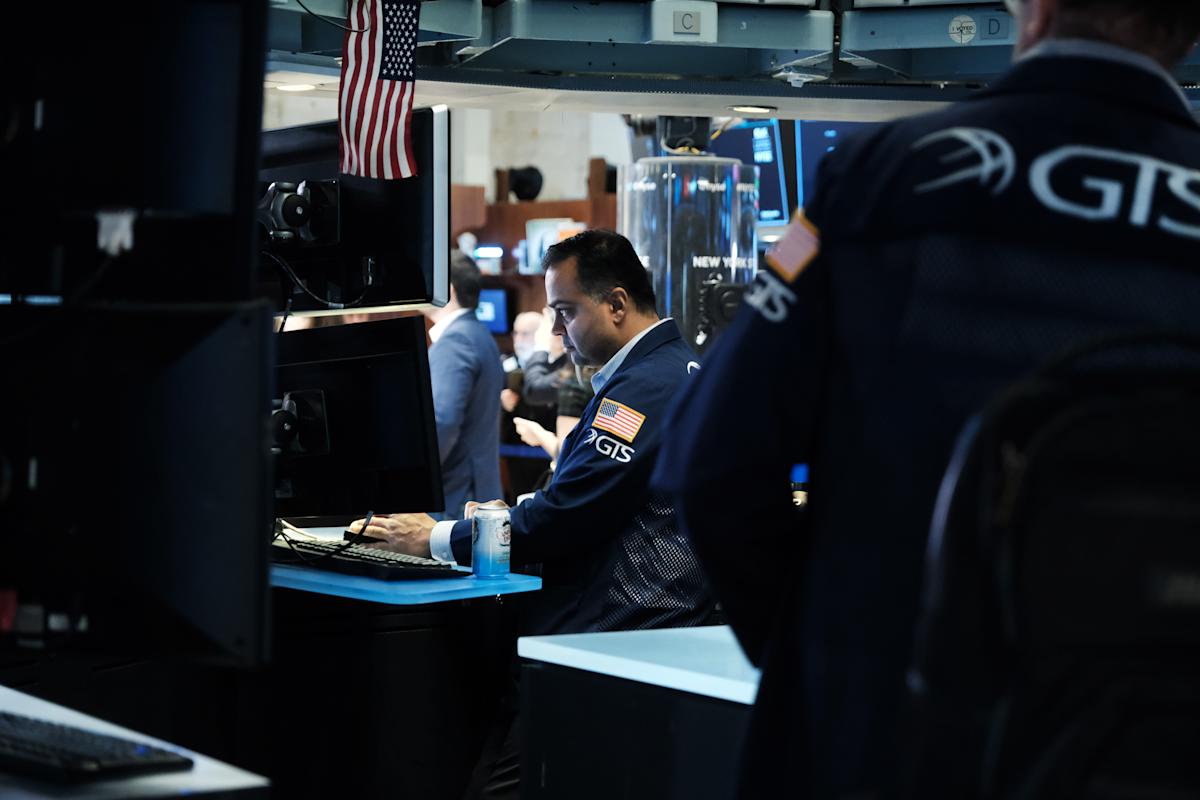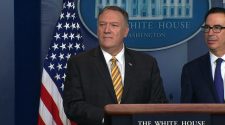Stocks rose Wednesday afternoon as traders considered the Federal Reserve’s latest monetary policy decision, in which the central bank hiked interest rates for the first time since 2018 in a move matching market expectations.
The S&P 500, Dow and Nasdaq rebounded in the final 30 minutes of trading after declining in the immediate aftermath of the Fed’s latest policy decision released at 2 p.m. ET. Treasury yields built on earlier gains. The yield curve inverted at one point as the yield on the shorter-duration and more policy-sensitive 5-year note jumped above that on the 10-year note.
Investors considered the Federal Reserve’s latest monetary policy decision, which showed the first of what will likely be a series of interest rate hikes this year. The central bank raised rates by 25 basis points, with this hike coming in-line with expectations.
Prior to Wednesday, benchmark interest rate had been kept near zero since mid-2020, with the central bank using low rates and a series of other monetary policy tools to keep financial conditions running smoothly amid the pandemic. The Fed last raised interest rates over three years ago.
Fed Chair Jerome Powell had already told Congress in recent weeks that he would back a 25 basis point interest rate hike at the Fed’s March meeting, beginning the process of tightening financial conditions to gradually bring down demand and inflation. And in opting against a more aggressive 50 basis point rate hike — which some market participants had called for at the beginning of the year — the Fed also avoided delivering a shock to markets already reeling from Russia’s invasion of Ukraine.
And importantly, in addition to offering a decision on raising rates, the Fed also released an updated Summary of Economic Projections, or “dot plot,” showing what central bank officials are thinking for where interest rates and growth in the economy may be headed in the near-term.
The median member of the Federal Open Market Committee (FOMC) anticipates the Fed will raise interest rates up to six more times this year, according to the dot plot. And this comes as the median member now expects core Personal Consumption Expenditures (PCE)— or the Fed’s preferred inflation gauge excluding volatile food and energy prices — to end the year rising 4.1%, up sharply from a December projection of 2.7%. This metric last rose at a 6.1% annual rate in January. And since then, more recent prints on consumer and producer price inflation have pointed to even steeper run-up in prices.
The major indexes held gains on Wednesday even after a new report on retail sales earlier in the morning showed a sharper than expected deceleration in consumer spending last month, with rising inflation beginning to curb some discretionary purchases. Elsewhere, developments on the Russia-Ukraine crisis appeared incrementally more positive. At least one Kremlin official reportedly struck an upbeat tone on discussions with Ukraine early Wednesday, helping provide a boost to stocks recently roiled by geopolitical turmoil. Kremlin spokesperson Dmitry Peskov suggested a proposal to have Ukraine become a neutral country while keeping its armed forces “could be viewed as a certain kind of compromise,” Bloomberg reported earlier Wednesday.
Energy prices steadied after unwinding recent gains. West Texas intermediate (CL=F) crude oil futures briefly dipped below $95 per barrel to fall further into a bear market before rising more than 1% intraday. Earlier this week, U.S. crude oil first entered bear market territory, with prices sliding more than 20% from recent closing highs set just a week ago. Brent crude, the international standard, hovered below $100 per barrel.
—
4:05 p.m. ET: Stocks post back-to-back days of gains after Fed raises rates as expected, signals additional hikes: Nasdaq jumps 3.8%, Dow adds 519 points, or 1.6%
Here were the main moves in markets as of 4:05 p.m. ET:
-
S&P 500 (^GSPC): +95.41 (+2.24%) to 4,357.86
-
Dow (^DJI): +518.76 (+1.55%) to 34,063.10
-
Nasdaq (^IXIC): +487.93 (+3.77%) to 13,436.55
-
Crude (CL=F): -$1.40 (-1.45%) to $95.04 a barrel
-
Gold (GC=F): -$1.10 (-0.06%) to $1,928.60 per ounce
-
10-year Treasury (^TNX): +2.8 bps to yield 2.1880%
—
2:25 p.m. ET: Fed updates monetary policy statement to reflect Russia-Ukraine, reduce pandemic mentions
The Federal Reserve’s updated monetary policy statement Wednesday included a number of major language changes, including a notable drop in the number of mentions of the impacts the pandemic is having across the economy. Instead, the central bank called attention to renewed concerns brought on by Russia’s war in Ukraine.
“The invasion of Ukraine by Russia is causing tremendous human and economic hardship,” the new statement said in its second paragraph. “The implications for the U.S. economy are highly uncertain, but in the near term the invasion and related events are likely to create additional upward pressure on inflation and weigh on economic activity.”
The Fed also removed a mention from the January statement that “the path of the economy continues to depend on the course of the virus.”
—
2:18 p.m. ET: Stocks lower after Fed raises interest rates, revises inflation expectations higher
Here’s where markets were trading as investors considered the Fed’s latest policy decision:
-
S&P 500 (^GSPC): +17.57 (+0.41%) to 4,280.02
-
Dow (^DJI): -15.89 (-0.05%) to 33,528.45
-
Nasdaq (^IXIC): +155.25 (+1.21%) to 13,106.28
-
Crude (CL=F): -$0.40 (-0.41%) to $96.04 a barrel
-
Gold (GC=F): -$16.50 (-0.86%) to $1,913.20 per ounce
-
10-year Treasury (^TNX): +7.5 bps to yield 2.235%
—
1:58 p.m. ET: Stocks hold onto gains heading into Fed decision
The three major indexes remained in positive territory just before the release of the Fed’s latest monetary policy decision.
The Nasdaq Composite outperformed, rising 2.3%. The Dow added 272 points, or 0.8%, while the S&P 500 was up 1.3%. The 10-year Treasury yield added about 3 basis points to hover above 2.19%, or the highest since 2019.
—
10:46 a.m. ET: Homebuilders’ sentiment falls to lowest level since September
Sentiment among homebuilders dropped to the lowest level in six months in March, with labor and other supply-side disruptions now compounding with rising mortgage rates to pressure the housing market.
The National Association of Home Builders’ March housing market index fell to 79 from February’s reading of 81. Consensus economists were looking for another reading of 81 in March, according to Bloomberg consensus data.
“Builders are reporting growing concerns (up 20% over the last 12 months) and expected higher interest rates connected to tightening monetary policy will price prospective home buyers out of the market,” said Robert Dietz, chief economist at the NAHB, in a statement.
—
9:33 a.m. ET: Stocks open higher, jumping more than 1% after the opening bell:
Here’s where stocks were trading just after market open:
-
S&P 500 (^GSPC): +45.38 (+1.06%) to 4,307.83
-
Dow (^DJI): +365.46 (+1.09%) to 33,909.80
-
Nasdaq (^IXIC): +183.07 (+1.41%) to 13,132.18
-
Crude (CL=F): +$1.47 (1.52%) to $97.91 a barrel
-
Gold (GC=F): -$10.50 (-0.54%) to $1,919.20 per ounce
-
10-year Treasury (^TNX): +0.3 bps to yield 2.163%
—
8:38 a.m. ET: Retail sales decelerate in February, rising 0.3% versus 0.4% expected
U.S. retail sales decelerated more than expected in February following an upwardly revised jump in January, with inflation weighing on consumer sentiment and spending.
Retail sales rose 0.3% in February compared to January, the Commerce Department said Wednesday. This came in below the 0.4% rise expected, based on Bloomberg consensus data. however, retail sales for January were upwardly revised sharply to show a 4.9% jump in January, versus the 3.8% increase previously reported.
Much of February’s gain was linked to spending at gas stations, with this rising 5.3% during the month and by 36.4% compared to February last year. Excluding automobile and gas prices, retail sales fell 0.4% month-on-month in February, versus an increase of 0.4% expected. Retail sales excluding autos and gas had risen 5.2% in January compared to December.
Other categories posted notable declines in February. Non-store retailers, or e-commerce outlets, saw sales drop 3.7% in February. Health and personal care store sales dropped 1.8%, and furniture and appliance store sales dipped 1%.
—
7:08 a.m. ET. Wednesday: Stock futures jump
Here’s where markets were trading Wednesday morning:
-
S&P 500 futures (ES=F): +51.5 points (+1.21%) to 4,313.50
-
Dow futures (YM=F): +358.00 points (+1.07%) to 33,890.00
-
Nasdaq futures (NQ=F): +238.00 points (+1.77%) to 13,689.75
-
Crude (CL=F): -$0.38 (-0.39%) to $96.06 a barrel
-
Gold (GC=F): -$6.10 (-0.32%) to $1,923.60 per ounce
-
10-year Treasury (^TNX): +0.2 bps to yield 2.162%
—
6:13 p.m. ET Tuesday: Stock futures mixed, Dow futures gain 250+ points
Here’s where stocks were trading Monday morning:
-
S&P 500 futures (ES=F): -3.5 points (-0.08%) to 4,258.50
-
Dow futures (YM=F): -22 points (-0.07%) to 33,510.00
-
Nasdaq futures (NQ=F): -1.5 points (-0.01%) to 13,450.25
—
Emily McCormick is a reporter for Yahoo Finance. Follow her on Twitter
Read the latest financial and business news from Yahoo Finance

Follow Yahoo Finance on Twitter, Instagram, YouTube, Facebook, Flipboard, and LinkedIn















